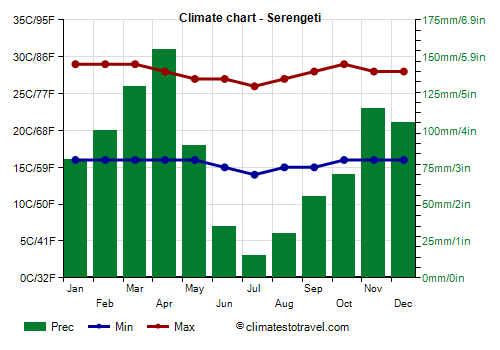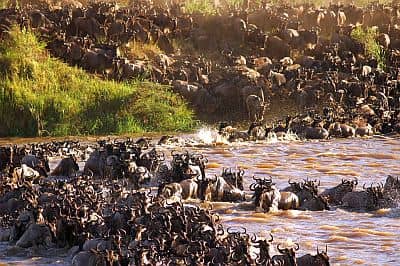Select units of measurement for the temperature and rainfall tables (metric or imperial).
Average weather, temperature, rainfall, sunshine hours

The climate of the Serengeti National Park is
subtropical, with a dry and relatively cool season from May to August, a warmer and still quite dry season in September and October, and a rainy and quite hot season from November to April.
The park is located at an altitude between 1,100 and 2,000 meters (3,600 and 6,600 feet); the altitude tempers the heat, so, even though we are just south of the Equator, it can get cool at night, or even cold in the highest areas and in the cool season. However, the sun is very strong, and requires appropriate protection, especially when it passes through the zenith at mid-day (ie around mid-March and late September).
Here are the average temperatures at the Ikoma Safari Camp, located at 1,400 meters (4,600 feet) of altitude.
Serengeti - Average temperatures|
| Month | Min | Max | Mean |
|---|
| January | 16 | 29 | 22.5 |
|---|
| February | 16 | 29 | 22.5 |
|---|
| March | 16 | 29 | 22.5 |
|---|
| April | 16 | 28 | 22 |
|---|
| May | 16 | 27 | 21.5 |
|---|
| June | 15 | 27 | 21 |
|---|
| July | 14 | 26 | 20 |
|---|
| August | 15 | 27 | 21 |
|---|
| September | 15 | 28 | 21.5 |
|---|
| October | 16 | 29 | 22.5 |
|---|
| November | 16 | 28 | 22 |
|---|
| December | 16 | 28 | 22 |
|---|
| Year | 15.6 | 27.9 | 21.7 |
|---|
amounts to around 900/1,000 millimeters (35/40 inches) per year in much of the park; in the north, it reaches 1,400 mm (55 in), while in the southeast, the most arid area, it drops below 800 mm (31.5 in). The rainy season, which, as mentioned, goes from November to April, is actually divided into two, with an interim period in January and February, which, however, is not very dry: from October to December, it's the "short rains season", and from March to May (but from February to April in the southern part) it's the "long rains season". Consequently, in January and February, the rains diminish, though not in a very pronounced way, in fact, they are still between 80 and 100 mm (3.1 and 4 in) per month.
Here is the average precipitation.
Serengeti - Average precipitation| Month | Days |
|---|
| January | 80 | 14 |
|---|
| February | 100 | 14 |
|---|
| March | 130 | 18 |
|---|
| April | 155 | 22 |
|---|
| May | 90 | 18 |
|---|
| June | 35 | 8 |
|---|
| July | 15 | 6 |
|---|
| August | 30 | 7 |
|---|
| September | 55 | 7 |
|---|
| October | 70 | 10 |
|---|
| November | 115 | 17 |
|---|
| December | 105 | 16 |
|---|
| Year | 980 | 157 |
|---|

The park is famous for the animals of the savannah, but especially for the so-called "
Great Migration", which involves about two million mammals, especially wildebeest and zebras: they move throughout the year between the Serengeti and the neighbouring
Masai Mara, in Kenya, while their predators, such as hyenas and big cats, are more stationary. The animals perform a circular migration, staying in the Serengeti from November to June, while from July to October, they move to the Mara, especially in August and September. The reason why the animals migrate to the north in this period (which corresponds to the austral winter), is that the dry season in the Serengeti is more pronounced than in the Mara, which is located closer to the Equator and therefore remains wetter, and equipped with lusher pastures. The exact location where the herds are to be found at any given time depends on the rains, and therefore can not be predicted with certainty, however, we can give some general indications.
In January and February, the animals are scattered south of the Serengeti, in the area of the Olduvai Gorge, north of the
Ngorongoro crater, in a semi-arid zone where the grass is low, and it's easy to spot any predators such as hyenas and lions, of which there is no shortage.
Between February and March, the animals give birth to puppies, who become immediately able to move independently, and head west, towards the area of Lake Ndutu.
In March, the season of the long rains begins, and the animals follow the lightnings, which are signs of thunderstorms, and move to the north, in search of green pastures, entering the Serengeti and heading towards the swamps to the west of Seronera, in the direction of Lake Victoria.
Between May and June, they go into heat and mate, and then continue to the north, heading towards the Grumeti River, which they will have to cross, each time choosing a different point. In June and July, they move towards the Masai Mara, in the northeast. From July to October, they remain in the Masai Mara, where they move around in search of available pastures. From late October to December, in the short rains season, they return in the Serengeti, moving southward.
The Serengeti National Park borders other parks, like the aforementioned Mara in Kenya and the Ngorongoro to the southeast, the Maswa Game Reserve to the southwest, and the Grumeti and Ikorongo Game Reserves to the north-west.
The amount of
sunshine in the Serengeti is good most of the year, since the rains usually occur in the form of downpours or thunderstorms in the afternoon. However, in the period of the long rains, rainfall and cloud cover can last longer, even though the sun shines for a few hours a day. Here are the average sunshine hours per day.
Serengeti - Sunshine hours| Month | Average | Total |
|---|
| January | 8 | 250 |
|---|
| February | 8 | 225 |
|---|
| March | 8 | 250 |
|---|
| April | 7 | 210 |
|---|
| May | 8 | 250 |
|---|
| June | 8 | 240 |
|---|
| July | 8 | 250 |
|---|
| August | 8 | 250 |
|---|
| September | 8 | 240 |
|---|
| October | 8 | 250 |
|---|
| November | 8 | 240 |
|---|
| December | 8 | 250 |
|---|
| Year | 7.9 | 2890 |
|---|

Best Time
As regards to the climate, the
best time in the Serengeti is the dry season,
from June to September; it's better to be equipped for cool or cold temperatures at night, especially at higher altitudes. In September, the temperatures begin to increase, and it can get a bit hot at lower elevations. During the month of October, the short rains season begins.
In June, the herds of wildebeest are located in the northwestern part of the park, in the area of the Grumeti and Mara rivers (Mara Region), where you can watch them when crossing rivers, while in July, they move to the Masai Mara.
At the end of October or in November, the wildebeest return to the Serengeti, when, however, the short rains season has begun. To watch them in the other seasons, you can therefore choose
January and February, in the "short dry season", when they are in the southern part of the park or in nearby Ngorongoro, and are in breeding season.